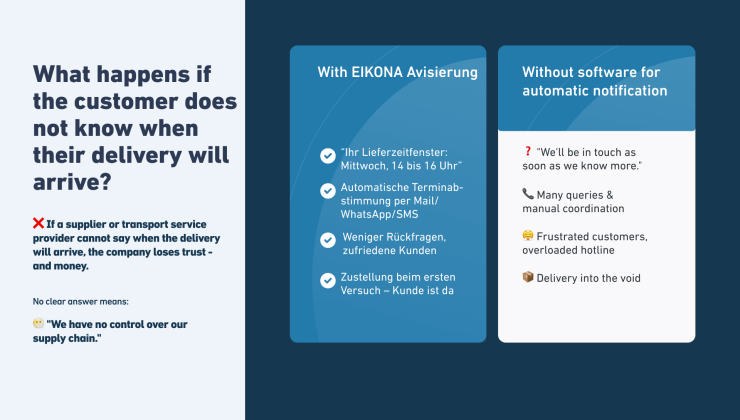As a project manager, he ensures that customer projects are realised in a structured, efficient and successful manner.


Punctuality is not just a virtue: in logistics, it is elementary because one process interlocks with the next and delays or unnecessary waiting times often trigger chain reactions. When customers – whether in the B2B or B2C sector – call and ask where their delivery is, this is not a good sign. After all, a stable supply chain should not only be transparent enough to ensure that everyone involved always knows the current delivery status, but should also include the timely notification of deliveries. Don’t worry, this sounds more complex than it is. Good notification software is the key!
The term “notification” refers to the announcement of an imminent delivery (or sometimes collection) of goods. Today, it is a central component of logistics processes, both in the B2B and B2C sectors. The aim is to inform the recipient of the arrival of the goods in due time. APIs (programming interfaces) ensure that the notification data is transmitted electronically to other systems such as the transport management system (TMS).
Typically, a dispatch notification contains important preliminary information from the delivery documents, i.e. details of the delivery date, article number, weight, quantity and volume. This makes it easier to plan inbound shipments and organise processes more efficiently. Especially in complex supply chains, notification ensures greater transparency and minimises waiting times or planning errors. In short: those who use notification avoid surprises. Because nobody really wants surprises in logistics.
Imagine that you, as a freight forwarder, have a lorry full of different consignments that need to be delivered – everything from a wardrobe to a children’s bed kit to a fridge. Unfortunately, you don’t meet all your customers, either because no appointment was made, they didn’t get the notification, or you are delayed by a traffic jam. So, you have to take some of the load back with you, store it temporarily (where should it all go?) and hope for better luck with the delivery the next day. Customers, on the other hand, are unhappy because they must wait longer for the delivery, and the shipper may receive negative reviews. This shows: In logistics, everyone involved benefits from well-coordinated delivery processes and a notification sent on time.
“Your order will arrive tomorrow between 7 a.m. and 7 p.m.” In the “phrases you like to hear” category, this probably ranks somewhere between “Oh, should I order the present for Lukas?” and “I’ve eaten the leftover pizza, surely you didn’t want it, did you?”. After all, nobody likes to spend their whole day at home, condemned to wait for the parcel, which, according to Murphy’s Law, either arrives punctually at 7.30 pm, the following day or in the ten minutes you’re in the shower.
Good notification certainly looks different. Ideally, delivery times should be specified as precisely as possible and never exceed a period of twelve hours. The whole thing works even better if the recipient is involved in the process. If time slots are available for selection when ordering the goods or booking a dispatch, the recipient can simply specify the delivery date on which they can accept the goods. The delivery process can then be conveniently tracked live via an online portal right up to the arrival of the goods, so that everyone is always up to date.
Keeping additional staff on hand to notify shipments? That’s unnecessary. In the past, a few employees were solely responsible for informing customers about the upcoming delivery, but today this can be done fully automatically with the help of notification software. Recipients are contacted via e-mail, text message or automatic voice call and can prepare for the delivery.
The automatic driver notification goes one step further: based on the lorry’s position data, the voice computer automatically announces the delivery to the recipient shortly before arrival. This means that the driver has one less task to complete and language barriers no longer play a role.
The result: saved time (and therefore also saved money). Employees can pursue more important activities than spending hours announcing shipments over the phone, and delivery attempts are successful.
A message can only be received if the right channel is used – makes sense. Anyone who can only call landline numbers these days is not keeping up with the times: after all, many businesses and end customers no longer have a real telephone but only use their mobile phones. But even the call itself is not always very popular: sometimes there is no reception, sometimes it is too loud to make a call, or it is simply not convenient – not to mention the time that such a call takes.
The solution: Simply notify them via WhatsApp! After all, a short notification is all you need to announce the delivery time. If you don’t want to use the Messenger app for business purposes, you can easily fall back on other RCS standards (Rich Communication Services). This way, the advance information about the upcoming delivery is sure to arrive.

Theory is good, but reality is better? In our case studies you can find out everything about the practical implementation of EIKONA notification.
If you not only want to offer your customers punctual delivery on the desired date, but also have other services up your sleeve, you can kill several birds with one stone with the notification software. Do you offer value-added services such as connection and assembly, the disposal of packaging, the unloading of lorries on the customer’s ramp or the arrangement of alternative dates? Great, all of this can be conveniently booked by the recipient via the same online portal. Ideally, it is possible to create separate rules for B2B and B2C bookings.
In general, “personalisation of the solution” and “orientation towards the customer” are the two aspects in which notification tools can and should continue to develop. After all, customers are more satisfied the better the solution fits their respective needs – ergo, software should also reflect this.
Short message, big impact: notification is the centrepiece of communication between the recipient and the shipping company. It creates transparency, shows the respective delivery status and thus contributes to customer loyalty. Everyone involved benefits from automatic notification: recipients know exactly when they can expect the goods to be delivered, shippers score points with on-time deliveries on the desired date, and freight forwarders are successful with the first delivery attempt and do not have to store the consignment temporarily. The big plus: today, no-one really has to spend ages calling people, because good software notifies fully automatically and via the desired channel.